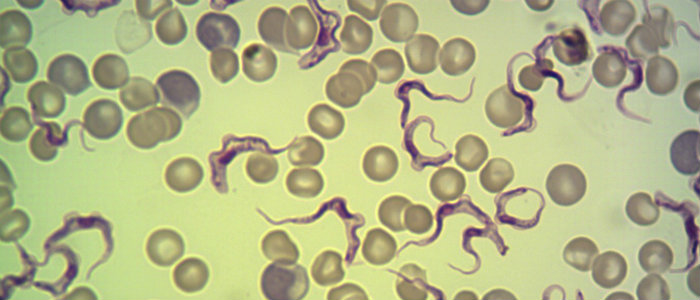Research could lead to more effective treatment of Sleeping Sickness
Published: 8 January 2020
A major collaboration between the Institute's Professor Harry de Koning and groups at two Belgian universities could have important implications in the creation of much-needed advanced drugs for combatting the deadly infection in its advanced stages

Combining tubercidin and cordycepin scaffolds results in highly active candidates to treat late-stage sleeping sickness
A major collaboration between iii's Professor Harry de Koning and groups at two Belgian universities, in Ghent and Antwerp, headed by Professors Van Calenbergh and Caljon, has been published in the journal Nature Communications.
The work describes the development of potent new compounds that can cure advanced sleeping sickness in an animal model, which could have important implications in the creation of much-needed advanced drugs for more effective treatment of the deadly infection.
The contribution of the Glasgow-based group was to evaluate how the new drugs, which are structural analogues of the DNA building-block adenosine, enter the parasite.
Prof de Koning said: "The parasite cannot make adenosine itself so is taking it up from the host environment - your blood - using specialist proteins embedded in its cell surface. We also looked at whether the new compounds would work against existing multi-drug resistant strains.
"Together with a further collaborator, Dr Anders Hofer at the University of Umea, Sweden, we also investigated what happens with the drug once it enters the parasite, how it is modified by its enzymes into something that subsequently kills the cell."
Explaining the overall research, he added: "Sleeping sickness - a deadly infection in sub-Saharan Africa that most people have either never heard of, or think is something from colonial times.
"In fact, the parasites, called Trypanosoma brucei, are doing fine and millions of people are at risk of this infection, which is transmitted by tsetse flies.
"The disease progresses from an early stage, with the parasite living and proliferating in the patient’s blood, to a second stage in which the parasite has entered the brain and is causing neurological symptoms, including the characteristic disturbance of the sleep/wake cycle, leading ultimately to coma and death.
"There are no documented cases of anyone surviving late-stage sleeping sickness without effective treatment with appropriate drugs - but almost all the drugs are very old and have severe, harmful side effects.
"New drugs are therefore needed and this paper describes the development of potent new compounds that can cure even advanced sleeping sickness in an animal model. Follow-on work, exploring how we can modify the new compounds for even greater effectiveness, is ongoing.
"The first follow-on paper, extending the experimental compound series and systematically extending our understanding of which structural modifications lead to the highest anti-parasite activity, was accepted by the European Journal of Medicinal Chemistry on Christmas eve and a further paper from this collaboration is under consideration by the Journal of Medicinal Chemistry.
"Moreover, we are urgently expanding the work to the parasite species that infect livestock rather than humans in Africa, for which no new drugs have been introduced since the 1960s."
Read the work of Hulpia F, Mabille D, Campagnaro GD, Schuman G, Maes L, Roditi I, Hofer A, De Koning HP, Galjon G, Van Calenbergh S (2019) here ⬇️
https://www.nature.com/articles/s41467-019-13522-6
https://www.sciencedirect.com/science/article/pii/S0223523419311766
First published: 8 January 2020

